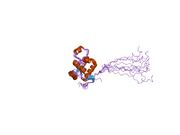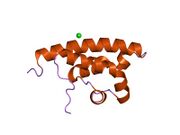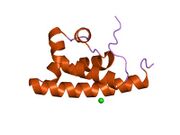Biology:Werner syndrome helicase
 Generic protein structure example |
Werner syndrome ATP-dependent helicase, also known as DNA helicase, RecQ-like type 3, is an enzyme that in humans is encoded by the WRN gene. WRN is a member of the RecQ Helicase family.[1] Helicase enzymes generally unwind and separate double-stranded DNA. These activities are necessary before DNA can be copied in preparation for cell division (DNA replication). Helicase enzymes are also critical for making a blueprint of a gene for protein production, a process called transcription. Further evidence suggests that Werner protein plays a critical role in repairing DNA. Overall, this protein helps maintain the structure and integrity of a person's DNA.
The WRN gene is located on the short (p) arm of chromosome 8 between positions 12 and 11.2, from base pair 31,010,319 to base pair 31,150,818.
Structure and function
WRN is a member of the RecQ Helicase family. It is the only RecQ Helicase that contains 3' to 5' exonuclease activity. These exonuclease activities include degradation of recessed 3' ends and initiation of DNA degradation from a gap in dsDNA. WRN is important in repair of double strand breaks by homologous recombination[2][3] or non-homologous end joining,[4] repair of single nucleotide damages by base excision repair,[5][6][1] and is effective in replication arrest recovery.[7] WRN may also be important in telomere maintenance and replication, especially the replication of the G-rich sequences.[8]
WRN is an oligomer that can act as a monomer when unwinding DNA, but as a dimer in solution or a tetramer when complexed with DNA, and has also been observed in hexameric forms. The diffusion of WRN has been measured to 1.62 in nucleoplasm and 0.12 at nucleoli.[9] Orthologs of WRN have been found in a number of other organisms, including Drosophila, Xenopus, and C. elegans. WRN is important to genome stability, and cells with mutations to WRN are more susceptible to DNA damage and DNA breaks.[10]
The amino terminus of WRN is involved in both helicase and nuclease activities, while the carboxyl-terminus interacts with p53, an important tumor suppressor.[11] WRN may function as an exonuclease in DNA repair, recombination, or replication, as well as resolution of DNA secondary structures. It is involved in branch migration at Holliday junctions, and it interacts with other DNA replication intermediates.[7] mRNA that codes for WRN has been identified in most human tissues.[11]
Post-translational modification
Phosphorylation of WRN at serine/threonine inhibits helicase and exonuclease activities which are important to post-replication DNA repair. De-phosphorylation at these sites enhances the catalytic activities of WRN. Phosphorylation may affect other post-translational modifications, including sumoylation and acetylation.[8]
Methylation of WRN causes the gene to turn off. This suppresses the production of the WRN protein and its functions in DNA repair.[12]
Clinical significance
Werner syndrome is caused by mutations in the WRN gene.[11] More than 20 mutations in the WRN gene are known to cause Werner syndrome. Many of these mutations result in an abnormally shortened Werner protein. Evidence suggests that the altered protein is not transported into the cell nucleus, where it normally interacts with DNA.[13] This shortened protein may also be broken down too quickly, leading to a loss of Werner protein in the cell. Without normal Werner protein in the nucleus, cells cannot perform the tasks of DNA replication, repair, and transcription.[14] Researchers are still determining how these mutations cause the appearance of premature aging seen in Werner syndrome.
Roles in DNA repair pathways
Homologous recombinational repair
WRN is active in homologous recombination. Cells defective in the WRN gene have a 23-fold reduction in spontaneous mitotic recombination, with especial deficiency in conversion-type events.[15] WRN defective cells, when exposed to x-rays, have more chromosome breaks and micronuclei than cells with wild-type WRN.[16] Cells defective in the WRN gene are not more sensitive than wild-type cells to gamma-irradiation, UV light, 4 – 6 cyclobutane pyrimidines, or mitomycin C, but are sensitive to type I and type II topoisomerase inhibitors.[17] These findings suggested that the WRN protein takes part in homologous recombinational repair and in the processing of stalled replication forks.[18]
Non-homologous end joining
WRN has an important role in non-homologous end joining (NHEJ) DNA repair. As shown by Shamanna et al.,[4] WRN is recruited to double-strand breaks (DSBs) and participates in NHEJ with its enzymatic and non-enzymatic functions. At DSBs, in association with Ku (protein), it promotes standard or canonical NHEJ (c-NHEJ), repairing double-strand breaks in DNA with its enzymatic functions and with a fair degree of accuracy. WRN inhibits an alternative form of NHEJ, called alt-NHEJ or microhomology-mediated end joining (MMEJ). MMEJ is an inaccurate mode of repair for double-strand breaks.
Base excision repair
WRN has a role in base excision repair (BER) of DNA. As shown by Das et al.,[5] WRN associates with NEIL1 in the early damage-sensing step of BER. WRN stimulates NEIL1 in excision of oxidative lesions. NEIL1 is a DNA glycosylase that initiates the first step in BER by cleaving bases damaged by reactive oxygen species (ROS) and introducing a DNA strand break via NEIL1's associated lyase activity.[19] NEIL1 recognizes (targets) and removes certain ROS-damaged bases and then incises the abasic site via β,δ elimination, leaving 3′ and 5′ phosphate ends. NEIL1 recognizes oxidized pyrimidines, formamidopyrimidines, thymine residues oxidized at the methyl group, and both stereoisomers of thymine glycol.[20]
WRN also participates in BER through its interaction with Polλ.[6] WRN binds to the catalytic domain of Polλ and specifically stimulates DNA gap filling by Polλ over 8-oxo-G followed by strand displacement synthesis. This allows WRN to promote long-patch DNA repair synthesis by Polλ during MUTYH-initiated repair of 8-oxo-G:A mispairs.
Replication arrest recovery
WRN is also involved in replication arrest recovery. If WRN is defective, replication arrest results in accumulation of DSBs and enhanced chromosome fragmentation.[21] As shown by Pichierri et al.,[21] WRN interacts with the RAD9-RAD1-HUS1 (9.1.1) complex, one of the central factors of the replication checkpoint. This interaction is mediated by the binding of the RAD1 subunit to the N-terminal region of WRN and is instrumental for WRN relocalization to nuclear foci and its phosphorylation in response to replication arrest. (In the absence of DNA damage or replication fork stalling, WRN protein remains localized to the nucleoli.[22]) The interaction of WRN with the 9.1.1 complex results in prevention of DSB formation at stalled replication forks.[21]
WRN deficiencies in cancer
Cells expressing limiting amounts of WRN have elevated mutation frequencies compared with wildtype cells.[23] Increased mutation may give rise to cancer. Patients with Werner Syndrome, with homozygous mutations in the WRN gene, have an increased incidence of cancers, including soft tissue sarcomas, osteosarcoma, thyroid cancer and melanoma.[24]
Mutations in WRN are rare in the general population. The rate of heterozygous loss of-function mutation in WRN is approximately one per million. In a Japanese population the rate is 6 per 1,000, which is higher, but still infrequent.[25]
Mutational defects in the WRN gene are relatively rare in cancer cells compared to the frequency of epigenetic alterations in WRN that reduce WRN expression and could contribute to carcinogenesis. The situation is similar to other DNA repair genes whose expression is reduced in cancers due to mainly epigenetic alterations rather than mutations (see Frequencies of epimutations in DNA repair genes).[citation needed]
The table shows results of analysis of 630 human primary tumors for WRN CpG island hypermethylation.[26] This hypermethylation caused reduced protein expression of WRN, a common event in tumorigenesis.[26]
| Cancer | Frequency of reduction in cancer[26] |
|---|---|
| Colorectal cancer | 37.9% |
| Non-small cell lung cancer | 37.5% |
| Gastric cancer | 25% |
| Prostate cancer | 20% |
| Breast cancer | 17.2% |
| Thyroid cancer | 12.5% |
| Non-Hodgkin lymphoma | 23.7% |
| Acute myeloblastic leukemia | 4.8% |
| Chondrosarcomas | 33.3% |
| Osteosarcomas | 11.1% |
Interactions
Werner syndrome ATP-dependent helicase has been shown to interact with:
- BLM[27]
- DNA-PKcs,[28][29]
- FEN1,[30][31]
- Ku70,[32][33]
- Ku80,[32][33]
- P53,[34][35]
- PCNA,[36][37]
- TERF2,[38] and
- WRNIP1.[39]
References
- ↑ 1.0 1.1 Monnat RJ (October 2010). "Human RECQ helicases: roles in DNA metabolism, mutagenesis and cancer biology". Semin. Cancer Biol. 20 (5): 329–39. doi:10.1016/j.semcancer.2010.10.002. PMID 20934517.
- ↑ "Homologous recombination resolution defect in werner syndrome". Mol. Cell. Biol. 22 (20): 6971–8. 2002. doi:10.1128/mcb.22.20.6971-6978.2002. PMID 12242278.
- ↑ "DNA2 cooperates with the WRN and BLM RecQ helicases to mediate long-range DNA end resection in human cells". J. Biol. Chem. 289 (39): 27314–26. 2014. doi:10.1074/jbc.M114.578823. PMID 25122754.
- ↑ 4.0 4.1 "WRN regulates pathway choice between classical and alternative non-homologous end joining". Nat Commun 7: 13785. 2016. doi:10.1038/ncomms13785. PMID 27922005. Bibcode: 2016NatCo...713785S.
- ↑ 5.0 5.1 "The human Werner syndrome protein stimulates repair of oxidative DNA base damage by the DNA glycosylase NEIL1". J. Biol. Chem. 282 (36): 26591–602. 2007. doi:10.1074/jbc.M703343200. PMID 17611195.
- ↑ 6.0 6.1 "Involvement of Werner syndrome protein in MUTYH-mediated repair of oxidative DNA damage". Nucleic Acids Res. 40 (17): 8449–59. 2012. doi:10.1093/nar/gks648. PMID 22753033.
- ↑ 7.0 7.1 "The Werner syndrome protein: linking the replication checkpoint response to genome stability". Aging 3 (3): 311–8. 2011. doi:10.18632/aging.100293. PMID 21389352.
- ↑ 8.0 8.1 "Model of human aging: recent findings on Werner's and Hutchinson–Gilford progeria syndromes". Clin Interv Aging 3 (3): 431–44. 2008. doi:10.2147/CIA.S1957. PMID 18982914.
- ↑ "Dynamics of the DNA repair proteins WRN and BLM in the nucleoplasm and nucleoli". European Biophysics Journal 43 (10–11): 509–16. 2014. doi:10.1007/s00249-014-0981-x. PMID 25119658.
- ↑ "Roles of Werner syndrome protein in protection of genome integrity". DNA Repair (Amst.) 9 (3): 331–44. 2010. doi:10.1016/j.dnarep.2009.12.011. PMID 20075015.
- ↑ 11.0 11.1 11.2 Oshima J (2000). "The Werner syndrome protein: an update". BioEssays 22 (10): 894–901. doi:10.1002/1521-1878(200010)22:10<894::AID-BIES4>3.0.CO;2-B. PMID 10984715.
- ↑ "WRN". US National Library of Medicine. http://ghr.nlm.nih.gov/gene/WRN.
- ↑ "The spectrum of WRN mutations in Werner syndrome patients". Hum. Mutat. 27 (6): 558–67. 2006. doi:10.1002/humu.20337. PMID 16673358.
- ↑ Lebel M (2001). "Werner syndrome: genetic and molecular basis of a premature aging disorder". Cell. Mol. Life Sci. 58 (7): 857–67. doi:10.1007/s00018-001-8398-y. PMID 11497235.
- ↑ "Loss of Werner syndrome protein function promotes aberrant mitotic recombination". Genes Dev. 15 (8): 933–8. 2001. doi:10.1101/gad.877001. PMID 11316787.
- ↑ "Correlation between senescence and DNA repair in cells from young and old individuals and in premature aging syndromes". Mutat. Res. 316 (1): 37–48. 1994. doi:10.1016/0921-8734(94)90006-x. PMID 7507567.
- ↑ "A deletion within the murine Werner syndrome helicase induces sensitivity to inhibitors of topoisomerase and loss of cellular proliferative capacity". Proc. Natl. Acad. Sci. U.S.A. 95 (22): 13097–102. 1998. doi:10.1073/pnas.95.22.13097. PMID 9789047. Bibcode: 1998PNAS...9513097L.
- ↑ "Werner helicase relocates into nuclear foci in response to DNA damaging agents and co-localizes with RPA and Rad51". Genes Cells 6 (5): 421–30. 2001. doi:10.1046/j.1365-2443.2001.00433.x. PMID 11380620.
- ↑ "Inhibition of DNA glycosylases via small molecule purine analogs". PLOS ONE 8 (12): e81667. 2013. doi:10.1371/journal.pone.0081667. PMID 24349107. Bibcode: 2013PLoSO...881667J.
- ↑ "Variant base excision repair proteins: contributors to genomic instability". Seminars in Cancer Biology 20 (5): 320–8. Oct 2010. doi:10.1016/j.semcancer.2010.10.010. PMID 20955798.
- ↑ 21.0 21.1 21.2 "The RAD9-RAD1-HUS1 (9.1.1) complex interacts with WRN and is crucial to regulate its response to replication fork stalling". Oncogene 31 (23): 2809–23. 2012. doi:10.1038/onc.2011.468. PMID 22002307.
- ↑ "Werner's syndrome protein (WRN) migrates Holliday junctions and co-localizes with RPA upon replication arrest". EMBO Rep. 1 (1): 80–4. 2000. doi:10.1093/embo-reports/kvd004. PMID 11256630.
- ↑ "The Werner syndrome exonuclease facilitates DNA degradation and high fidelity DNA polymerization by human DNA polymerase δ". J. Biol. Chem. 287 (15): 12480–90. 2012. doi:10.1074/jbc.M111.332577. PMID 22351772.
- ↑ "Excess of rare cancers in Werner syndrome (adult progeria)". Cancer Epidemiol. Biomarkers Prev. 5 (4): 239–46. 1996. PMID 8722214.
- ↑ "The Werner's Syndrome RecQ helicase/exonuclease at the nexus of cancer and aging". Hawaii Med J 70 (3): 52–5. 2011. PMID 21365542.
- ↑ 26.0 26.1 26.2 "Epigenetic inactivation of the premature aging Werner syndrome gene in human cancer". Proc. Natl. Acad. Sci. U.S.A. 103 (23): 8822–7. 2006. doi:10.1073/pnas.0600645103. PMID 16723399. Bibcode: 2006PNAS..103.8822A.
- ↑ "Colocalization, physical, and functional interaction between Werner and Bloom syndrome proteins". J. Biol. Chem. 277 (24): 22035–44. June 2002. doi:10.1074/jbc.M200914200. PMID 11919194.
- ↑ "Substrate specificities and identification of putative substrates of ATM kinase family members". J. Biol. Chem. 274 (53): 37538–43. Dec 1999. doi:10.1074/jbc.274.53.37538. PMID 10608806.
- ↑ "Werner protein is a target of DNA-dependent protein kinase in vivo and in vitro, and its catalytic activities are regulated by phosphorylation". J. Biol. Chem. 277 (21): 18291–302. May 2002. doi:10.1074/jbc.M111523200. PMID 11889123.
- ↑ "Stimulation of flap endonuclease-1 by the Bloom's syndrome protein". J. Biol. Chem. 279 (11): 9847–56. March 2004. doi:10.1074/jbc.M309898200. PMID 14688284.
- ↑ "Werner syndrome protein interacts with human flap endonuclease 1 and stimulates its cleavage activity". EMBO J. 20 (20): 5791–801. October 2001. doi:10.1093/emboj/20.20.5791. PMID 11598021.
- ↑ 32.0 32.1 "Ku heterodimer binds to both ends of the Werner protein and functional interaction occurs at the Werner N-terminus". Nucleic Acids Res. 30 (16): 3583–91. August 2002. doi:10.1093/nar/gkf482. PMID 12177300.
- ↑ 33.0 33.1 "Functional interaction between Ku and the werner syndrome protein in DNA end processing". J. Biol. Chem. 275 (37): 28349–52. September 2000. doi:10.1074/jbc.C000289200. PMID 10880505.
- ↑ "The processing of Holliday junctions by BLM and WRN helicases is regulated by p53". J. Biol. Chem. 277 (35): 31980–7. August 2002. doi:10.1074/jbc.M204111200. PMID 12080066.
- ↑ "p53 Modulates the exonuclease activity of Werner syndrome protein". J. Biol. Chem. 276 (37): 35093–102. September 2001. doi:10.1074/jbc.M103332200. PMID 11427532.
- ↑ "Characterisation of the interaction between WRN, the helicase/exonuclease defective in progeroid Werner's syndrome, and an essential replication factor, PCNA". Mech. Ageing Dev. 124 (2): 167–74. February 2003. doi:10.1016/S0047-6374(02)00131-8. PMID 12633936.
- ↑ "Characterization of the human and mouse WRN 3'-->5' exonuclease". Nucleic Acids Res. 28 (12): 2396–405. June 2000. doi:10.1093/nar/28.12.2396. PMID 10871373.
- ↑ "Telomere-binding protein TRF2 binds to and stimulates the Werner and Bloom syndrome helicases". J. Biol. Chem. 277 (43): 41110–9. October 2002. doi:10.1074/jbc.M205396200. PMID 12181313.
- ↑ "A novel protein interacts with the Werner's syndrome gene product physically and functionally". J. Biol. Chem. 276 (23): 20364–9. June 2001. doi:10.1074/jbc.C100035200. PMID 11301316.
Further reading
- "The Werner syndrome protein at the crossroads of DNA repair and apoptosis". Mech Ageing Dev 125 (8): 521–8. 2004. doi:10.1016/j.mad.2004.06.004. PMID 15336909. https://zenodo.org/record/894614.
- "Pathways and functions of the Werner syndrome protein". Mech Ageing Dev 126 (1): 79–86. 2005. doi:10.1016/j.mad.2004.09.011. PMID 15610765.
- Monnat RJ Jr; Saintigny Y (2004). "Werner syndrome protein--unwinding function to explain disease". Sci Aging Knowledge Environ 2004 (13): re3. doi:10.1126/sageke.2004.13.re3. PMID 15056797. https://hal-cea.archives-ouvertes.fr/cea-01938173/file/Sageke_Werner.pdf.
- "Current advances in unraveling the function of the Werner syndrome protein". Mutat Res 577 (1–2): 237–51. 2005. doi:10.1016/j.mrfmmm.2005.03.020. PMID 15946710.
- "The Werner syndrome protein has separable recombination and survival functions". DNA Repair (Amst) 3 (5): 475–82. 2004. doi:10.1016/j.dnarep.2004.01.002. PMID 15084309. http://monnatlab.gs.washington.edu/pdf/2004_Swanson.pdf.
- "WRN mutations in Werner syndrome". Hum. Mutat. 13 (4): 271–9. 1999. doi:10.1002/(SICI)1098-1004(1999)13:4<271::AID-HUMU2>3.0.CO;2-Q. PMID 10220139.
- "The many substrates and functions of ATM". Nat. Rev. Mol. Cell Biol. 1 (3): 179–86. 2001. doi:10.1038/35043058. PMID 11252893.
External links
- Werner Syndrome. University of Washington, Seattle. February 2012. NBK1514. https://www.ncbi.nlm.nih.gov/books/NBK1514/. In Adam, M. P.; Everman, D. B.; Mirzaa, G. M.; Pagon, R. A.; Wallace, S. E.; Bean LJH; Gripp, K. W.; Amemiya, A. (1993). GeneReviews [Internet]. Seattle WA: University of Washington, Seattle. https://www.ncbi.nlm.nih.gov/books/n/gene/TOC/.
- GeneCard
- Werner Syndrome Mutational Database
 |










